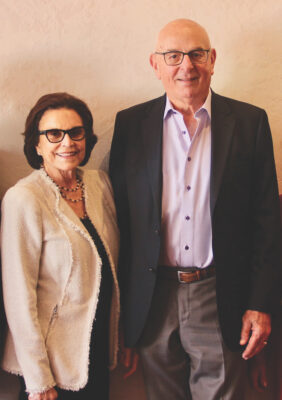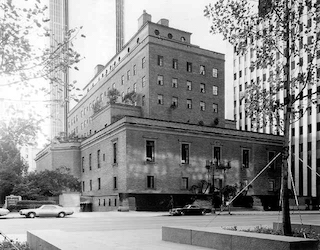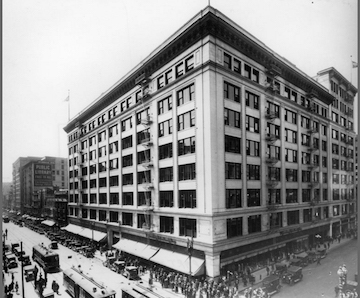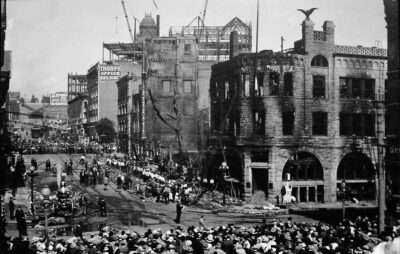A quick trip through Los Angeles history with Wayne Ratkovich

LUNCHEON SPEAKER Wayne Ratkovich and Jo Ann.
Wayne and Jo Ann Ratkovich have lived in Windsor Square and Hancock Park (and Windsor Square again) for most of the past 50 years. Wayne has become a “famous real estate developer,” especially because of his interest in historic preservation. (He preceded me in serving a nine-year term as a Trustee of the National Trust for Historic Preservation.)
Wayne has won many well-deserved awards. For example, last summer, the Los Angeles Chapter of the American Institute of Architects recognized him as a Presidential Honoree. Named the “Merry Norris Design Advocate – Developer” for 2020, Wayne was singled out for his work in “city building since 1977.”
Just a few weeks ago, the “Los Angeles Times” had a major feature story about San Pedro and the “West Harbor” dining, shopping and entertainment complex emerging on the site of the former Ports O’ Call. The project is being built by the Ratkovich Company and Jerico Development of San Pedro.
In the spring of last year, Wayne’s wife, Jo Ann, convinced him that a lot of her local friends in the Auxiliary of the Hospital of the Good Samaritan would enjoy hearing from him about local real estate development and his role in it. That indeed was the case. Interested Auxiliary members and guests filled a room at Wilshire Country Club to hear Wayne’s presentation. Lucky to attend on behalf of the Chronicle, and as a longtime real estate person myself, I was singularly impressed with what Wayne had to say. I later convinced him to let the Larchmont Chronicle share his remarks with a far wider local audience.
Wayne told the guests that he “would like to share some thoughts about Los Angeles including what I think are the agents of change in Los Angeles and in cities throughout our country and the world.” He said he would conclude those thoughts by recounting his own company’s “experience with historic preservation and what I have discovered about the importance of preservation over the past few decades.”
This talk took place in May of 2019, a year before COVID-19 arrived, of course. But the talk covers a long stretch of Los Angeles history, a period that included the arrival and departure of the Spanish flu as well as other detours on the road to where our city is today and where it is going. Regardless of the coronavirus bump in the road, I find Wayne’s predictions for the future to be sound, and I believe readers will find his talk of interest.
[This is the first of two parts. The second part will appear in our January issue.]
THE CITY
By Wayne Ratkovich

THE CALIFORNIA CLUB, founded in 1887, is among three clubs that had significant early influence on the growing city.
Let’s take a quick trip through our city’s history. The shortcut I will take is looking at the city in 50-year increments beginning in 1900, with a second increment beginning in 1950 and the third in 2000. This commentary focuses on Downtown Los Angeles where, I believe, the city’s history began and is most interesting.
1900 – 1950
Just prior to 1900, three clubs were formed that were to have a significant influence on the growing city — the Los Angeles Athletic Club in 1880, The California Club in 1887, and the Jonathan Club in 1895. Members of these clubs have been significant forces in the growth and history of Los Angeles.
Railroads came to town in a big way. The Santa Fe Railroad opened a line linking Los Angeles to the rest of the nation with the price of tickets as low as $1, no doubt contributing to the population boom that was about to occur.
The Pacific Electric Railway was created in 1901 by Henry Huntington and Isaias W. Hellman to connect Los Angeles to the outlying suburbs. In 1944, there were 109 million riders transported on 1,150 miles of track.
In 1901, Huntington also founded the Los Angeles Railway, the company that operated the Yellow Cars — the streetcars that served the nearby neighborhoods. According to some historic accounts, the Yellow Cars carried more passengers than the Red Cars.
Population growth followed the rails and the sunny weather. In 1900 the city’s population was just a shade over 100,000 and by 1950 it reached two million residents.
Spring Street emerged as the “Wall Street of the West” with a stunning growth of buildings and enterprises.

BROADWAY DEPARTMENT STORE at 4th and Broadway.
Starting with the Hellman and the Continental buildings in 1902, buildings constructed during the boom included Crocker Bank, Farmers and Merchants, Title Insurance, the Rowan, the Security, the Spring Arcade, the Los Angeles Stock Exchange, Lloyd’s Bank, Pacific Southwest Bank, E.F. Hutton, California Canadian Bank, the Mortgage Guaranty Building, the Banks & Huntley Building, Barclay’s Bank, the A.G. Bartlett Building, the Bank of America and the Financial Center Building.
Retail also caught a wave into downtown with Arthur Letts’ Broadway Department Store at Fourth and Broadway in 1896. Letts also backed John Bullock, who founded Bullocks at Seventh and Broadway in 1907.
At the turn of the 20th century, A. Hamburger and Sons moved onto a site at Eighth and Broadway and built a department store that was to become the largest west of Chicago, later known as the May Company.
The Broadway Theater District included 12 theaters built between 1910 and 1931. They included the Cameo, the Arcade, the Palace, the Million Dollar, Loew’s, the Orpheum, the Rialto, the Globe, the United Artists and the Los Angeles.
Many of us remember Jack Smith, the gifted columnist for the “Los Angeles Times.” Here is what Jack Smith had to say about the theaters on Broadway:
“I remember walking into those opulent interiors, surrounded by the glory of the Renaissance, or the age of Baroque, and spending two or three hours in the dream world of the movies. When I came out again the sky blazed; the heat bounced off the sidewalk; traffic sounds filled the street; I was back in the hard reality of the Depression.”

L.A. TIMES BUILDING bombing was in 1910.
This from the “L.A. Times” in 2006: “There was a time, long ago, when the streets of downtown Los Angeles were awash in neon — thanks to a confluence of movie theaters the world had never seen before. Dozens of theaters screened Hollywood’s latest fare, played host to star-studded premieres and were filled nightly with thousands of moviegoers. In those days, before World War II, downtown L.A. was the movie capital of the world.”
Success came to Los Angeles despite the turbulence coming from the bombing of the L.A. Times building in 1910, WWI (1914-1918), WWII (1941-1945), the Los Angeles Aqueduct water wars of the teens and twenties, and the Great Depression of the 1930s.
In the first 50 years of the 20th century, Los Angeles became a real city, and downtown Los Angeles was the beating heart of the Southern California region. It was the center of banking, law, real estate, retail and entertainment — all made available to citizens living to the north, south, east and west. The next 50 years were quite different.
1950 to 2000
In 1915 there were 55,000 cars on the streets of Los Angeles. Today there are two million cars in Los Angeles and 5.5 million in the County of Los Angeles.
The automobile, freeways and the idealism of suburban living changed Southern California and all of Los Angeles. The changes in store for Downtown Los Angeles were historic, profound and enormous in scale.
The opening of the Arroyo Seco Parkway in 1940 and its direct connection to downtown in 1953 was a sign of what was coming. Freeways reaching out to West Los Angeles, the San Fernando Valley, the San Gabriel Valley, the South Bay and Orange County brought mobility to the surging population of Southern California that followed the end of World War II.
How could life be any better than to live in the suburbs of sunny Southern California? Mom, Dad, the two kids, the new home, a barbecue, and a pool — it just could not get any better. Ozzie and Harriet showed us the way.
The same mobility enabled industries, retailers and entertainment venues to head for the ’burbs. Homes for mall rats spread across the county with devastating consequences for urban retailers like those in Downtown Los Angeles.
Spring Street was all but vacated by the banks, law firms and brokerage houses that made the street such an important part of downtown.
Most of the Broadway theaters closed or changed their programming to appeal to Latino audiences. Broadway became a street dominated by retailers serving the Latino market. Streets were flooded with shoppers every day, and on weekends it was as much a social experience as a shopping trip.
In the second half of the century, leadership in the city began to shift from the private sector to City Hall. In 1955, the city adopted the Bunker Hill Urban Renewal Project, a huge site of 133 acres stretching from First to Fifth streets and from the Harbor Freeway to Hill Street. To make way for new development, eminent domain was widely used, ultimately leading to the demolition of an entire residential neighborhood.
To support the redevelopment cause, the city lifted the height limit for buildings in 1957. In 1968, Downtown Los Angeles got its first truly high-rise building, the 40-story Union Bank Plaza at Fifth and Figueroa.
In the meantime, leadership in the private sector was on the decline. A publication by USC’s Annenberg Center said the following: “In the early 50s, the Committee of 25, which, depending on your historical interpretation, was either an enormously powerful clique of the city’s business elite or a shadow government running the city [was active]. By either interpretation, this one centralized group of players was recognized as being the de facto power center in the City of Angels…. It was through their influence that the Brooklyn Dodgers became the Los Angeles Dodgers.” The meeting place for the Committee was The California Club.
Fall from grace
More from Annenberg: “The biggest change since (the early ’50s) has been the L.A. business community’s fall from grace. Once there was a myriad of large corporations with enormous footprints in Los Angeles: ARCO, Pacific Mutual, Security Pacific National Bank, Bullocks, United California Bank and Carter Hawley Hale. Most of those companies have either been bought or have simply left town.”
Los Angeles was no longer the dynamic city it was in the first 50 years of the century. Indeed, it was tagged as a “suburb in search of a city,” an unflattering but accurate label.
But the second half of the 20th century wasn’t all gloom and doom in downtown. In 1958, the Dodgers moved to Los Angeles and opened Dodger Stadium in 1962. In 1960, the Democratic Convention was held in Los Angeles and nominated the future president, John Kennedy. In 1962 the first Super Bowl was played in Los Angeles, and in 1990 the Metro Blue Line connected the downtowns of Los Angeles and Long Beach.
In 1964 the Dorothy Chandler Pavilion opened, and in 1967 both The Mark Taper Forum and the Ahmanson opened.
Office buildings were the primary form of development in downtown from the day the height limit was lifted. From 1983 until 1991, 22 million square feet of new office buildings were constructed downtown. Indeed, the city got the skyline it so badly wanted. These new office buildings were not great economic successes.
The largest hotel in the city, the Bonaventure, opened on Figueroa Street in downtown in 1972. The Broadway Plaza opened to great fanfare in 1973 when architect and developer Charles Luckman designed the first truly mixed-use property in Los Angeles — a hotel, an office building and a retail center all linked together.
In 1993, heavy rail transit finally came to Los Angeles, initially with a line running from Union Station to Seventh and Flower streets and later extending west to both North Hollywood and to Wilshire and Western.
Two good and important forces emerged during the century’s second half. One was the “Downtown News,” a publication born in 1972, and — in 1977 — the Los Angeles Conservancy held its first public meeting at the Oviatt Building in downtown. The “Downtown News” and the Conservancy have both served and supported downtown in a very positive and constructive way.
So, the second half of the 20th century saw the growth of the region being accommodated in the suburbs, but urbanity was not abandoned. Let’s go to the next 50 years — the period we live in now.
[From 2000 to 2050 will be the subject of next month’s conclusion of this essay.]
Category: People
